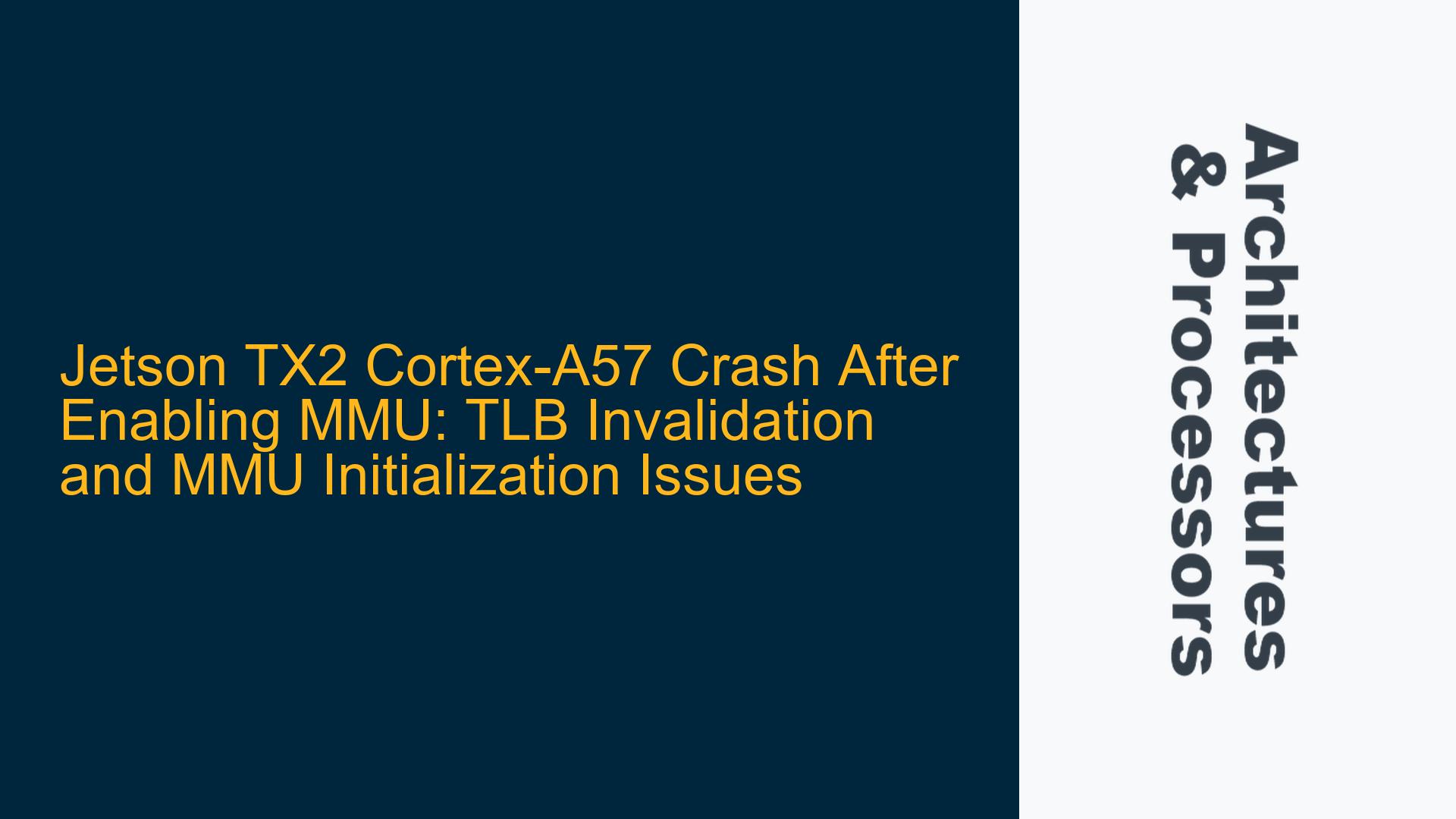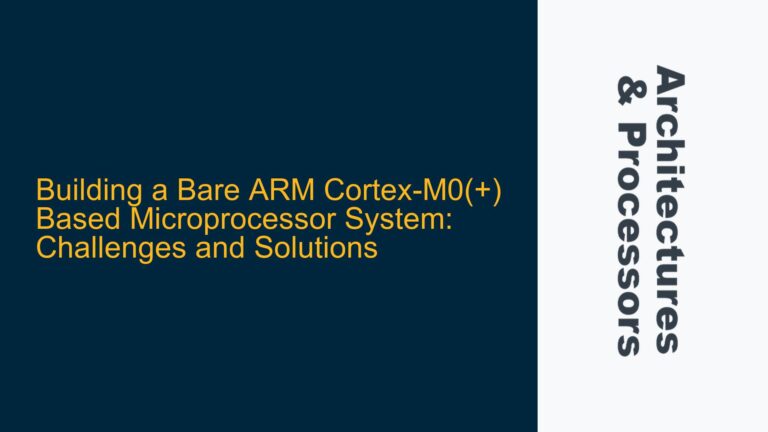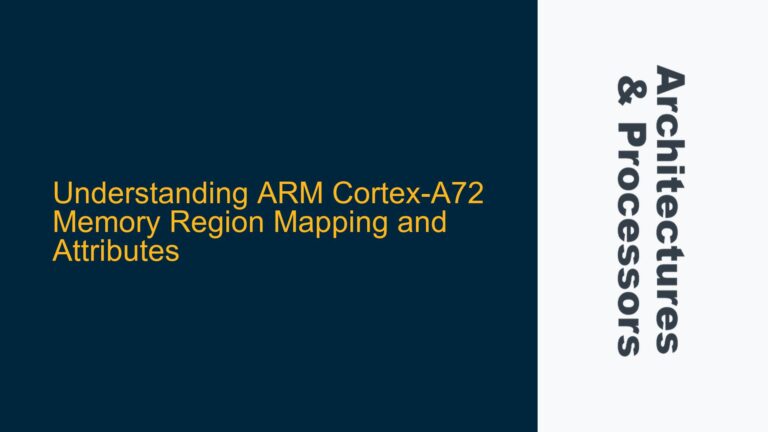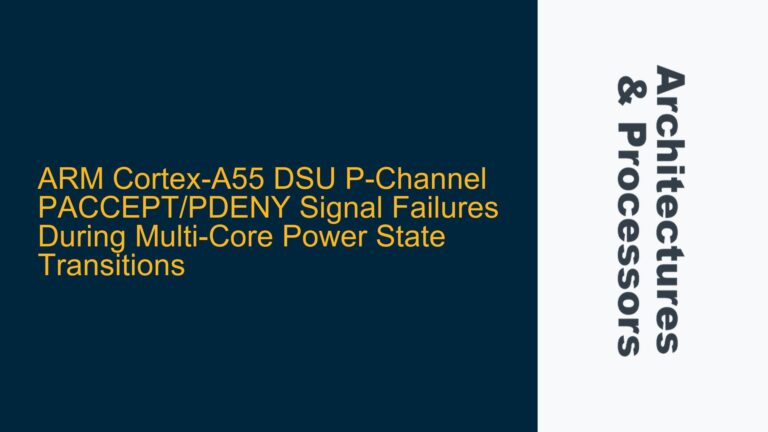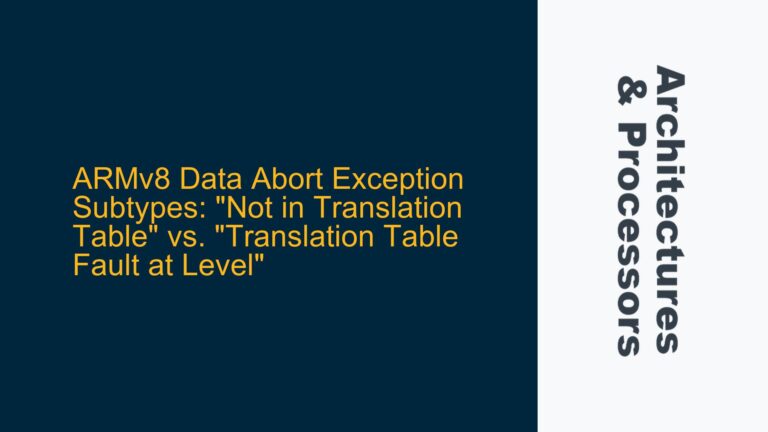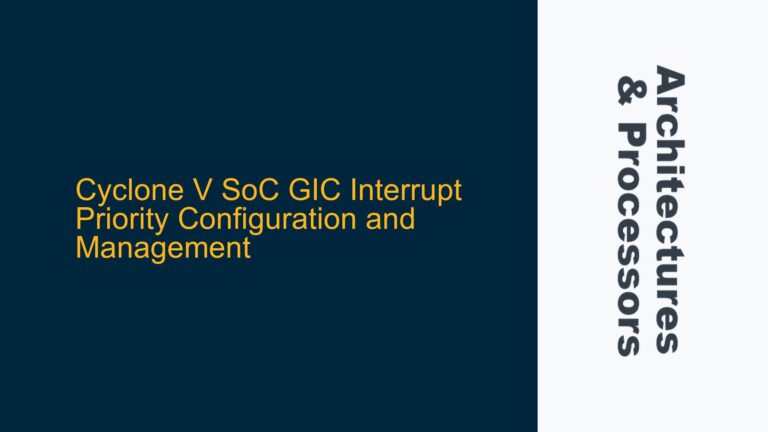Cortex-A57 MMU Initialization Crash During TLB Invalidation
The issue at hand involves a Cortex-A57 core on the NVIDIA Jetson TX2 platform crashing during the initialization phase when the Memory Management Unit (MMU) is enabled. The crash occurs specifically when executing the TLBI ALLE2 instruction, which invalidates all TLB entries at Exception Level 2 (EL2). The crash manifests in two scenarios:
- If
TLBI ALLE2is executed before enabling the MMU, the CPU crashes when the MMU is enabled by writing to theSCTLR_EL2register. - If
TLBI ALLE2is executed after enabling the MMU, the CPU crashes when theTLBI ALLE2instruction is followed by aDSB(Data Synchronization Barrier).
When the TLB is not invalidated at any point, the code runs without issues. The crash appears to be a stall or exception, but without a debugger, the exact cause is unclear. The user confirms that the issue occurs on a Cortex-A57 core, not a Denver core, as initially suspected.
This issue is critical because it prevents the proper initialization of the MMU, which is essential for virtual memory management and system stability. The problem likely stems from incorrect handling of TLB invalidation, MMU configuration, or address translation during the transition from physical to virtual memory.
Physical-Virtual Address Mismatch and TLB Invalidation Timing
The root cause of the crash is likely related to the timing and context of TLB invalidation, as well as potential mismatches between physical and virtual addresses during MMU initialization. Below are the key factors contributing to the issue:
1. Physical-Virtual Address Mismatch
When the MMU is enabled, the system transitions from using physical addresses to virtual addresses. If the physical address of the TLBI ALLE2 instruction before MMU enablement does not match its virtual address after MMU enablement, the CPU may attempt to execute the instruction from an incorrect address, leading to a crash. This mismatch can occur if the page tables are not correctly set up or if the translation regime is not properly configured.
2. TLB Invalidation Timing
The TLB must be invalidated at the correct time to ensure that stale entries do not cause incorrect address translations. Invalidating the TLB before enabling the MMU may leave the system in an inconsistent state, as the MMU expects valid TLB entries to perform address translations. Conversely, invalidating the TLB after enabling the MMU without proper synchronization (e.g., using DSB) can lead to race conditions or undefined behavior.
3. MMU Configuration and SCTLR_EL2 Settings
The SCTLR_EL2 register controls various aspects of the MMU, including its enablement. If the SCTLR_EL2 register is not configured correctly (e.g., incorrect endianness, cache settings, or alignment checks), enabling the MMU can result in unexpected behavior. Additionally, the interaction between the MMU and the TLB invalidation logic may not be properly synchronized, leading to crashes.
4. Exception Handling and Debugging Limitations
Without a debugger, it is challenging to pinpoint the exact cause of the crash. The CPU may be generating an exception (e.g., a translation fault or alignment fault) that is not being handled properly, causing the system to stall. The lack of debugging tools makes it difficult to verify the state of the CPU registers, memory, and MMU configuration at the time of the crash.
Correct MMU Initialization and TLB Invalidation Sequence
To resolve the issue, follow a systematic approach to ensure proper MMU initialization and TLB invalidation. The steps below outline the recommended sequence and precautions:
1. Verify Physical and Virtual Address Mapping
Before enabling the MMU, ensure that the physical address of the TLBI ALLE2 instruction matches its virtual address after MMU enablement. This can be achieved by:
- Setting up the page tables correctly to map the physical address space to the desired virtual address space.
- Ensuring that the translation regime (e.g., stage 1 or stage 2 translation) is configured appropriately for EL2.
- Using identity mapping (where physical addresses equal virtual addresses) during the initial MMU setup to simplify the transition.
2. Configure SCTLR_EL2 Correctly
Before enabling the MMU, configure the SCTLR_EL2 register with the appropriate settings:
- Enable the MMU by setting the
Mbit. - Configure the endianness, cache, and alignment check settings based on the system requirements.
- Ensure that the
I(instruction cache) andC(data cache) bits are set correctly to enable caching if needed.
3. Invalidate the TLB at the Correct Time
Invalidate the TLB after enabling the MMU to ensure that the MMU can perform address translations using valid TLB entries. Use the following sequence:
- Enable the MMU by writing to
SCTLR_EL2. - Execute a
DSBinstruction to ensure that the MMU enablement is complete. - Execute the
TLBI ALLE2instruction to invalidate all TLB entries at EL2. - Execute another
DSBinstruction to ensure that the TLB invalidation is complete. - Execute an
ISB(Instruction Synchronization Barrier) to flush the instruction pipeline and ensure that the CPU uses the updated TLB entries.
4. Handle Exceptions and Debugging
If the system continues to crash, implement exception handling to capture and log any faults generated by the CPU. Use the following steps:
- Set up exception vectors at EL2 to handle translation faults, alignment faults, and other exceptions.
- Use the
ESR_EL2(Exception Syndrome Register) to diagnose the cause of the exception. - If possible, use a debugger to inspect the state of the CPU registers, memory, and MMU configuration at the time of the crash.
5. Test and Validate
After implementing the above steps, test the system to ensure that the MMU is initialized correctly and that the TLB invalidation does not cause a crash. Use the following validation steps:
- Verify that the MMU is enabled by reading the
SCTLR_EL2register. - Test address translation by accessing memory using virtual addresses.
- Monitor the system for any unexpected behavior or crashes.
Example Code Sequence
Below is an example code sequence for enabling the MMU and invalidating the TLB on a Cortex-A57 core:
// Step 1: Set up page tables (identity mapping)
// Assume page tables are set up correctly in memory
// Step 2: Configure SCTLR_EL2
MOV X0, #0x1005 // Set M, I, and C bits
MSR SCTLR_EL2, X0 // Write to SCTLR_EL2
// Step 3: Enable MMU and synchronize
DSB SY // Ensure all previous operations are complete
ISB // Flush the instruction pipeline
// Step 4: Invalidate TLB and synchronize
TLBI ALLE2 // Invalidate all TLB entries at EL2
DSB SY // Ensure TLB invalidation is complete
ISB // Flush the instruction pipeline
// Step 5: Continue execution with MMU enabled
By following these steps, you can ensure that the MMU is initialized correctly and that TLB invalidation does not cause the system to crash. If the issue persists, consider using a debugger to further diagnose the problem and verify the system state.
This guide provides a comprehensive approach to troubleshooting and resolving MMU initialization and TLB invalidation issues on the Cortex-A57 core. By addressing the physical-virtual address mismatch, configuring the MMU correctly, and synchronizing TLB invalidation, you can achieve a stable and reliable system implementation.
